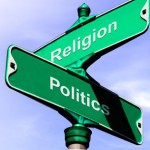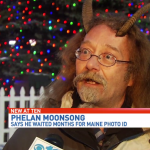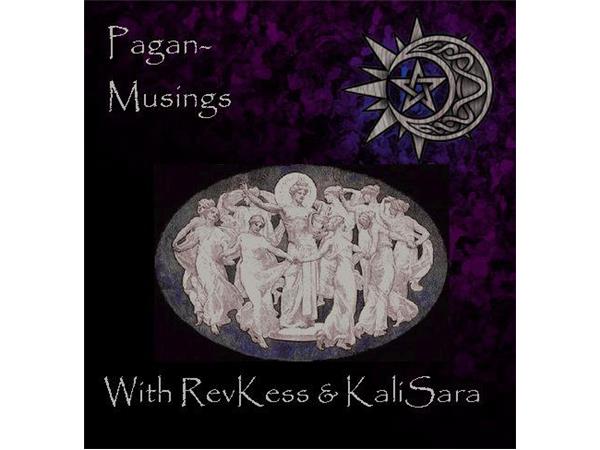“Am I Pagan?” Oh my god! Am I really writing about this again? This happens every time I have any significant contact with the Pagan community. Maybe that should tell me something.
This Pantheacon had a panel discussion about the question of Pagan identity. The moderator started the discussion by describing the Drew Jacob controversy from last year. I should be grateful for the controversy, because it introduced me to blogs and got me blogging. Anyway, although the constituency of the panel was not entirely as advertised, it turned out to be a good cross-section representation of the attendees I think: an eclectic Pagan, a witch, a magician, a Neo-Shaman, and a practitioner of an indigenous tradition and a reconstructionist tradition. (We were missing a druid, though.) There was also Oberon Zell, the person who is credited with coining the term “Pagan” (and “Neo-Pagan”) for this community. This is the 50th anniversary of the Church of All Worlds (CAW), founded by Zell. Zell sat in the middle of the presenter’s table, like a grand patriarch, in his purple wizard robes — a position I think he has earned.
Zell was not shy about comparing himself to Benjamin Franklin, who is credited with inventing “Americans”. He explained that when he chose “Pagan”, he was borrowing the term from a Discordian who was advocating the use of this appellation in his tradition. He explained that, when he used the term, he meant non-Christian, and was intentionally comparing Neo-Pagans to the Classical pagans and to Polynesian indigenous “pagans”. In other words, he was using the term in the same way that mainstream culture used it — more or less synonymously with polytheism. This went hand-in-hand with Zell’s other pluralistic concern: polyamory.
It wasn’t until 1971, four years after the founding of CAW, that Zell articulated his version of the Gaia hypothesis and earth-centeredness became a major part of CAW. Along with polytheism, earth-centeredness is the other key concept that Zell associated with his understanding of the word “Pagan”. Zell described the first time he heard the phrase “green religion” and grasped onto it. Zell seemed either out of touch with what is now going on in the Pagan community, or else he deliberately chose to ignore it. The understanding of Paganism as “earth-centered” or “nature religion” has now become somewhat passe, as it has become clear that “earth-centered” does not describe many who call themselves Pagan, including the more esoteric groups and reconstructionists.
If I had coined the term “Pagan”, though, I might also feel that I had the right to continue to define it. It was interesting to watch Zell declare that Paganism is green religion and then watch that declaration hang in the air. No one responded, and the subject was changed, but not until after a pregnant pause. I suspect Zell may have been thinking the pause was dramatic effect, but I think everyone was just weighing the wisdom of pointing out his error. The thing is, I actually agree with Zell to a certain extent — to me, Paganism (or at least Neopaganism) means green religion, or “deep green religion” (to borrow Brom Taylor’s term).
This is not the first time that Zell has lost control over the term of his own creation. I have often wondered how Wiccan liturgy made its way into the Church of All Worlds. Zell explained that this occurred through the Pagan Way liturgy which Ed Fitch began circulating in 1972. (Fitch was actually in attendance in the back of the room.) According to Zell, this was the first Pagan liturgy and he honored Fitch by telling us all what a great debt we owed to him. The Pagan Way liturgy had a life of its own, but CAW’s adoption of it no doubt helped its spread, especially on West Coast.
But Zell took issue with one effect of the Pagan Way materials. He explained how witches started referring to Pagans as a laity to which witches were a clergy. This was because the Pagan Way materials were conceived by some as “outer court” materials to the Gardnerian mysteries. Others, like Zell, treated the Pagan Way materials as a stand-alone tradition. Anyway, to Zell, the esotericist understanding of the term “Pagan” was problematic for groups like CAW, Feraferia, and the Church of the Eternal Source, which had grown up independently of witchcraft and did not consider themselves to be an “outer court” of witchcraft.
Although Zell did not mention it during the panel, CAW’s predecessor organization, Atl, was created in 1961, only a decade after Gardner made his witch cult public and two years before the Bucklands started initiating East Coast Americans into Gardnerian witchcraft. And, according to Fred Lamond, British Traditional Witchcraft did not arrive on the West Coast until 1973 (although there are some who think that Central Valley Wicca may predate that). In any case, at least in the U.S., non-Wiccan Paganism has as long a history was Wicca, especially on the West Coast. Zell’s sense of resentment over this issue was evident even now. He pointed out that, originally, witches did not even consider their craft a religion; in contrast, CAW was very self-consciously a religion, even a “church” — in fact, the first Neopagan church!
Ironically, CAW’s adoption of the Pagan Way materials probably compounded this confusion, since that liturgy was adapted by Ed Fitch from the Gardnerian witchcraft liturgy. (I should have asked Fitch what made him call his materials “Pagan” instead of “Witch”). The culmination of this co-opting of the Pagan term by witches, according to Zell, was the Covenant of the Goddess (CoG), which was an exclusively witch organization — which excluded CAW, in spite of the origin of its liturgy. Notably, the Zells and CAW were part of the predecessor ecumenical organizations (1972 Council of Themis and 1973 Council of Earth Religions) but not the 1975 CoG.
Zell was not the only one on the panel, obviously. There was a self-identified solitary, eclectic Pagan, Carl Neal. There was also a Witch, Christopher Penczak, a Neoshaman, “Lupa”, and a magician of the Golden Dawn and OTO variety, Brandy Williams. Their reactions to the question of Pagan identity were interesting as well.
Carl explained he used to wear a button that said “Pagan but not Wiccan”. There was a time when it was necessary for an eclectic Pagan to wear such a button, but I don’t think that’s the case any longer. Certainly eclectics continue to have the “not that kind of Pagan” discussion with non-Pagans. (I still have to have it myself.) But at Pantheacon, Wicca was not a dominating presence. In fact, rather than just assuming that everyone was Wiccan, the question of what type of Pagan you are was probably conversation topic number one at the Con.
It was interesting to contrast Carl’s response with Penczak, Lupa, and Brandy. For all three, “Pagan” is an umbrella term which includes them, but it is not their primary self-designation. Lupa especially described her path as unique to her alone — her “own little path” as she said. Her Neoshamanism is not the Michael Harner variety and she was at pains to emphasize how she must continually distinguish her practice from that of other Neoshamans, not to mention other Pagans.
Brandy compared her own use of the term “Pagan” to her use of the word “Woman”. She led a women-only ritual at the Con. You may remember this was a point of contention at last year’s Con, when some self-identified, but not biological, women were excluded from a women’s ritual. Actually, the same thing occurred this year at Z. Budapest’s ritual and I heard there was a staged protest outside the ritual. Budapest has been getting slack for her exclusionary policies since she invented feminist — i.e., male-excluded — witchcraft in 1971. But Brandy’s ritual was inclusive. She explained how she told the staff member controlling entry that, if someone with a beard came in, they were only to ask if the person was a woman, and if they responded “yes”, then they were to be allowed in. Similarly, she felt that “Pagan” should be as inclusive a term as possible.
In contrast to Penczak, Lupa, and Brandy, “Pagan” is not an umbrella term for Carl. “Pagan” is his primary self-designation. He made the point that he feels it is important to reclaim the term “Pagan”. I feel the same way. My identity as a Pagan is tied directly to the reclamation of that term from its Christian meaning, as I’ve blogged about before. The tension between those for whom “Pagan” is an umbrella term, who probably want maximum inclusiveness, and those for whom “Pagan” is a primary designator, who probably want more discrimination in the use of the term, is a subject that has not been well explored.
Last, but not least, on the panel was Tamara Suida. The previous night I had attended a Haitian Vodou ceremony (at least that’s what it claimed to be) — complete with a brief possession. The ritual was directed by by Mambo Chita Tann. The following morning, I went to a Kemetic Orthodox (Egyptian reconstructionist) ceremony led by Egyptologist and doctoral candidate Tamara Suida. When I walked into the Kemetic ceremony, I was shocked to discover that the soon-to-be-Dr. Suida and Mambo Tann were the same person! In addition to the two traditions already mention, Tamara said that she is also half Iroquois (Haudenosaunee).
Tamara was the only person on the panel who said she was not Pagan. Interestingly, her reasoning for not being Pagan paralleled Zell’s and Carl’s reason for being Pagan: “Pagan” carries with it a subtext, she said. It is a term which is intended to contrast with Judeo-Christianity, i.e., first and foremost it means “non-Christian”. Pagans often point out that there are other religious traditions which are not Abrahamic which are also not Pagan. But Paganism isn’t just non-Christian, it’s post-Christian. As I understand the the term, “Pagan” refers to those whose primary experience of divinity is not one of alienation (as it arguably is for Christians), but one of connection. T. Thorn Coyle has argued that this distinction is at the core of what makes us Pagan, and I agree.
Tamara went on to explain that she was raised in a culture that was comfortable with mixed religious identity. The Iroquois, according to her, were not forcibly assimilated, but rather sold their land, so they have a different relationship with the assimilator culture. Furthermore, she explained, most Haitian Voudoo practitioners would say they were Catholic if asked what their religion is (although Tamara said she is not Christian). Voudoo is replete with Christian imagery. The night before, the Vodou ritualists recited the Lord’s Prayer, Hail Mary, and the Apostles Creed as the prelude to the ceremony. Vodou, Tamara said, is like what witchcraft is to some people: a craft, not a religion. Since she does not feel the need to define herself in contrast to Christianity, she did not like the Pagan appellation. While acknowledging that “Pagan” is an umbrella term, she said, “but an umbrella is not the entire sky.”
So here we had three categories of people: those who define themselves primarily as Pagan (Zell and Carl), those who define themselves as Pagan, but use the term Pagan primarily as an umbrella term (Penczak, Lupa, and Brandy), and one who defined herself as non-Pagan, although her presence at Pantheacon possibly puts her on the boundary of that term.
I wonder whether it would be helpful to think of these three groups as three concentric circles. The first centers around the handle of the umbrella and identifies with the term Pagan in a strong way. The second falls under the umbrella proper, but not near the center, as other self-designations (“witch”, “druid”, “shaman”, etc.) draw these away from the center. And the last exists just beyond the circumference of the umbrella. Note: These circles do not describe the constituency of the Pagan community, but only the various relations to the term “Pagan”. And the placement of one group at the “center” is not intended to imply a privileging of that group or a license to define the term “Pagan” for the other groups. Obviously, as a naturalistic Pagan who eschews the practice of magic, I can hardly claim to be near the center of the Neopagan movement. Oberon Zell might still be able to claim that in some ways, but his understanding of Paganism seems a little out of touch with how the community is evolving at present.
What I get out of all this is that, when defining Paganism, it is important to keep in mind the perspective of the speaker. I think we sometimes make the mistake of thinking there is one conversation happening, when there are actually at least three. There are those holding onto the handle of the umbrella, so to speak, who are defining “Paganism” as their primary religious identity and who will try to narrow the definition accordingly. There are those who perceive themselves under the Pagan umbrella, but are not attached to the term “Pagan” as a primary religious identifier and who will try to broaden the definition so as to include themselves and others. Then there are those who do not perceive themselves under the umbrella at all, but are still standing near its circumference, and they will try to narrow the definition, but for a different reason than those holding onto the handle.











